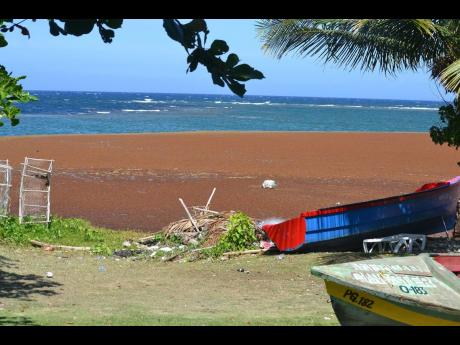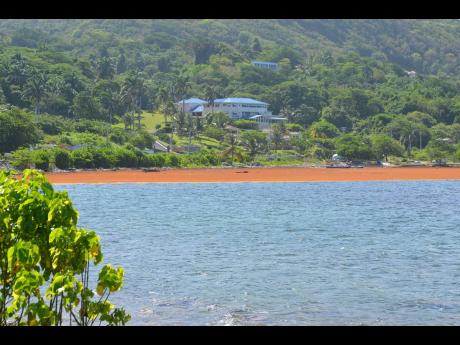Seaweed ambushes St Mary fishermen
While seagoing operations suffer, farmers slow to tap sargassum’s potential
Sargassum season is back, and the livelihoods of fishermen in the small community of Castle Gordon, located between Galina and Port Maria in St Mary, are already being adversely affected. In addition, the community is complaining of the stench...
Sargassum season is back, and the livelihoods of fishermen in the small community of Castle Gordon, located between Galina and Port Maria in St Mary, are already being adversely affected.
In addition, the community is complaining of the stench emanating from the decaying algae, which has covered a large area of the sea just across from the Casa Maria hotel.
While this is happening, farmers in the parish have not moved to tap the potential of the seaweed, which has been touted as being useful for many purposes, including being a cheaper source of fertiliser.
Leggo, a fisherman from Castle Gordon, told The Gleaner that he and several other fishermen in the community are struggling to survive because of the impact of the seaweed.
Leggo, who does net fishing, said the seaweed clogs their nets each time they are pulled and they have to spend up to six hours each day cleaning them before they can be relaunched. This has rendered fishing impractical in the current environment.
“It affect we a lot, because we do the net fishing. When we come from sea, fi draw in the net, pick off the fish them, clean off the seaweed and put the net dem inna di boat, it ah go tek we five or six hours extra. So it kinda stop we from go sea, cause it too much,” the frustrated fisherman said.
“It a affect mi very wickedly right now because mi cyaa get fi go fishing an’ ah di sea mi live off ah. A di sea ah mi main source of survival, right now. Right yah now, mi nuh know wha mi ah go do,” he continued.
He said that other fishermen in the community are in a similar position.
“Everybody affected, even the man dem wid fish pot ... . The man dem who go ocean, it nuh really bother them like that.”
Then there is the stench of the hydrogen sulfide that is emitted as the algae rots.
“Ah night time, when the place cool, it smell very horrible, trust mi,” he said of the odour, which is similar to that of rotting eggs.
And, although St Mary has over 13,000 registered farmers, it appears that there is currently no move to take advantage of the uses of the seaweed, despite spiralling fertiliser costs.
No fertiliser plan
Rural Agricultural Development Authority (RADA) Parish Manager Delroy Luke said that, while he has heard of the seaweed being used as fertiliser in some countries, he is unaware of any such move in the parish or, indeed, the island.
“We haven’t started to explore that as yet. I haven’t gotten any word from farmers in this regard,” Luke told The Gleaner.
In China, sargassum has been used as a low-cost fertiliser in sweet potato production, for example, as its high potash content makes it suitable for nourishing root crops.
It is also used to feed livestock and as landfill, and even as a health food, as it is said to be rich in carotenoids, which are also found in carrots, pumpkins, and some seafood.
The Caribbean Alliance for Sustainable Tourism, in its document titled Sargassum – A Resource Guide for the Caribbean, has suggested that ministries of agriculture run tests on the sargassum to ensure there are no contamination factors, and for a better understanding of the correct nutrient contents and techniques for usage of the seaweed.
Meanwhile, Daveian Morrison, managing director of local sargassum-based company Awganic Inputs, said his company is getting ready to roll out its first line of products next month.
“We have two products that are coming on stream right now. One of them is a charcoal and one of them is [an animal] feed,” Morrison told The Gleaner Thursday evening.
Morrison said he has a feed order to fill in July and expects the charcoal to be on the market in August.
He views the advent of seaweed similar to that of petroleum, where persons were sceptical of it until they warmed up to its many uses.


